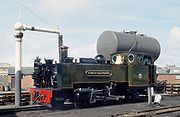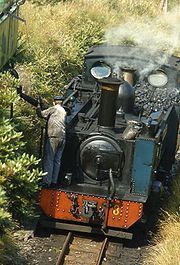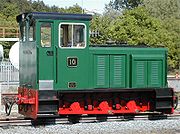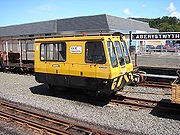
Vale of Rheidol Railway locomotives
Encyclopedia





Vale of Rheidol Railway
The Vale of Rheidol Railway is a narrow-gauge gauge heritage railway that runs for between Aberystwyth and Devil's Bridge in the county of Ceredigion, Wales...
, which runs from Aberystwyth
Aberystwyth
Aberystwyth is a historic market town, administrative centre and holiday resort within Ceredigion, Wales. Often colloquially known as Aber, it is located at the confluence of the rivers Ystwyth and Rheidol....
to Devil's Bridge (Wales), opened in 1902, and was later operated by the Cambrian Railway, Great Western Railway
Great Western Railway
The Great Western Railway was a British railway company that linked London with the south-west and west of England and most of Wales. It was founded in 1833, received its enabling Act of Parliament in 1835 and ran its first trains in 1838...
and British Rail
British Rail
British Railways , which from 1965 traded as British Rail, was the operator of most of the rail transport in Great Britain between 1948 and 1997. It was formed from the nationalisation of the "Big Four" British railway companies and lasted until the gradual privatisation of British Rail, in stages...
before being 'privatised' in 1989 and run as a heritage railway
Heritage railway
thumb|right|the Historical [[Khyber train safari|Khyber Railway]] goes through the [[Khyber Pass]], [[Pakistan]]A heritage railway , preserved railway , tourist railway , or tourist railroad is a railway that is run as a tourist attraction, in some cases by volunteers, and...
operation (though arguably it had operated as a Heritage Railway operation since the mid-1930s, when the GWR withdrew freight services and winter passenger services, rendering the railway wholly reliant on the tourist trade). It is built to gauge.
No 1, & No 2 (later 1212 & 1213)
The VoR commenced operations with two 2-6-22-6-2
Under the Whyte notation for the classification of steam locomotives, 2-6-2 represents the wheel arrangement of two leading wheels, six coupled driving wheels and two trailing wheels.Other equivalent classifications are:...
T locomotives constructed by Davies & Metcalfe of Manchester
Manchester
Manchester is a city and metropolitan borough in Greater Manchester, England. According to the Office for National Statistics, the 2010 mid-year population estimate for Manchester was 498,800. Manchester lies within one of the UK's largest metropolitan areas, the metropolitan county of Greater...
, Nos.1 and 2. These locomotives were given Nos.1212 and 1213 by the GWR when it took over the line on grouping. They were Davies and Metcalfe's first locomotives and a Great Central Railway
Great Central Railway
The Great Central Railway was a railway company in England which came into being when the Manchester, Sheffield and Lincolnshire Railway changed its name in 1897 in anticipation of the opening in 1899 of its London Extension . On 1 January 1923, it was grouped into the London and North Eastern...
boilersmith, Thomas Kay, provided expertise in their construction. The contract was given to a company previously inexperienced in locomotive building (although previously they were involved in the repair of locomotives and made injectors) because Mr. Metcalfe was an Aberystwyth man. The design draws inspiration from the Manning Wardle
Manning Wardle
Manning Wardle was a steam locomotive manufacturer based in Hunslet, Leeds, West Yorkshire, England.- Precursor companies :The city of Leeds was one of the earliest centres of locomotive building; Matthew Murray built the first commercially successful steam locomotive, Salamanca, in Holbeck, Leeds,...
2-6-2Ts on the then-newly-opened Lynton and Barnstaple Railway
Lynton and Barnstaple Railway
The Lynton & Barnstaple Railway opened as an independent railway in May 1898. It was a single track narrow gauge railway slightly over long running through the rugged and picturesque area bordering Exmoor in North Devon, England. Although opened after the 1896 Light Railways Act came into force,...
, to which they bear some resemblance.
No 3 (later 1198)
No. 3 was a small 2-4-02-4-0
Under the Whyte notation for the classification of steam locomotives, 2-4-0 represents the wheel arrangement of two leading wheels on one axle, four powered and coupled driving wheels on two axles, and no trailing wheels....
T locomotive, originally built by Bagnall
Bagnall
Bagnall could be:*Bagnall, Staffordshire*Anthony Bagnall, a senior Royal Air Force commander*Drew Bagnall, Canadian ice hockey player*Geoff Bagnall, Australian rugby league footballer*Gibbons Bagnall...
of Stafford
Stafford
Stafford is the county town of Staffordshire, in the West Midlands region of England. It lies approximately north of Wolverhampton and south of Stoke-on-Trent, adjacent to the M6 motorway Junction 13 to Junction 14...
for a Brazilian cane plantation in 1896 but never delivered as the order was cancelled, Bagnall regauging the locomotive from to when it was sold to the Plynlimon and Hafan Tramway
Plynlimon and Hafan Tramway
The Plynlimon and Hafan Tramway was a gauge narrow gauge railway in Cardiganshire in Mid Wales. It ran from Llanfihangel station on the Cambrian Railways via the village of Talybont and the valley of the Afon Leri into the foothills of Plynlimon Fawr...
and named Talybont. In 1903, after the failure of the Plynlimon and Hafan, it was purchased by the VoR, regauged to and renamed Rheidol. The GWR numbered it 1198 in 1923, but it was withdrawn and scrapped the following year, having never carried its GWR number.
No 4
In 1902 the railway's Directors temporarily hired a locomotive from the Ffestiniog RailwayFfestiniog Railway
The Ffestiniog Railway is a narrow gauge heritage railway, located in Gwynedd, Wales. It is a major tourist attraction located mainly within the Snowdonia National Park....
. The engine sent was Ffestiniog No 4 'Palmerston'
Ffestiniog Railway rolling stock
The Ffestiniog Railway owns and operates a number of heritage and modern-day steam and diesel locomotives. A full list of these locomotives with details of their operational status is provided below.-Locomotives:...
. The following year VoR engine No 3 'Rheidol' was acquired (see entry above), but a need for a fourth locomotive was still discerned. Palmerston No 4 was therefore hired again from Ffestiniog, and became the regular fourth engine for the next twenty years, being hired for several long periods, interspersed with brief home visits to Ffestiniog. The engine carried fleet number '4' in reference to its position on its home railway, although the number also matched its position on the Vale of Rheidol, as the fourth engine. When the line was acquired by the Great Western Railway, the leased locomotive was no longer required and was returned to Ffestiniog (from where it was immediately re-hired to the Welsh Highland Railway, to assist with construction). Palmerston (an 0-4-0ST+T) was built in 1864 by George England of New Cross, the fourth of the original four Ffestiniog Railway locomotives and was named after the Prime Minister, Viscount Palmerston.
No 7, No 8, & No 9 (& re-use of '1213')
Shortly after taking control of the line, the GWR overhauled No 1212 (No 1) and under the pretence of a 'heavy rebuild' actually built an entirely new 1213, the original (No 2) presumably being scrapped. At the same time, two new locomotives (numbered 7 and 8) were built to the same design as the new No 1213 at the GWR's Swindon WorksSwindon Works
Swindon railway works were built by the Great Western Railway in 1841 in Swindon in the English county of Wiltshire.-History:In 1835 Parliament approved the construction of a railway between London and Bristol. Its Chief Engineer was Isambard Kingdom Brunel.From 1836, Brunel had been buying...
. In 1946, the GWR undertook a renumbering of the remaining locomotives inherited from pre-Grouping companies, and this saw the 'new' 1213 being renumbered as No 9. The original No 1 (No 1212) had been withdrawn in the 1930s and after a while scrapped, as it was found that three engines (7, 8, & 9) could quite easily cope with day to day operation of the railway.
It is still possible to find references (in print, and on-line) to the mistaken belief that No 9 is one of the original Davies & Metcalfe Locomotives, as some websites and books incorrectly perpetuate this myth, having been successfully hoodwinked by the coverup at Swindon Works. The Works were very effective in their coverup, entitling the parts that made up the new No 1213 as 'spares' in the accounts book, as the GWR Board had only given them leave to build two new locomotives (No 7 & No 8). A simple test to prove that No 9 is actually of the same vintage as No 7 & No 8 is to compare the working drawings between it and a Davies and Metcalfe locomotive — Rheidol historian C C Green, who carried out this comparison, stated of all three current locomotives that "mechanically they are identical", and having compared the current No 9 (the 'new' 1213) with the plans of the original 1213 stated that "no single part" of the original locomotive could possibly have fitted the new one.
Along with other ex-GWR locomotives, No 7, No 8, & No 9 all retained their numbers under British Rail ownership, and in 1956 were given the names which they still carry today, being unnamed up to that point. These three locos were the only steam engines to survive in BR's ownership after the end of mainline steam traction in August 1968, excluding steam powered cranes which remained in service until 1995. Under the TOPS
TOPS
Total Operations Processing System, or TOPS, is a computer system for managing the locomotives and rolling stock owned by a rail system...
numbering arrangements introduced at this time they were allocated Class 98
British Rail Class 98
TOPS Class 98 has been used to cover all steam locomotives used on the mainline in Britain, but also has a particular usage for the three Vale of Rheidol Railway-design 2-6-2T locomotives that remained in the ownership of British Rail after the end of mainline steam traction in August 1968...
and were nominally numbered 98007–98009, but these numbers were never actually carried on the locomotives. All three locomotives, and the rolling stock, carried standard British Rail 'rail blue' livery until the 1980s, when the locomotives were given more traditional liveries that they had carried in the past. The rail blue livery has now gone, but these three locomotives remain in use on the VoR today, now back in private hands through the ownership of the Phyllis Rampton Trust
Phyllis Rampton Trust
The Phyllis Rampton Narrow Gauge Railway Trust is a British charity which is registered with the British Charity Commission as 292240 under the classification of "Education/TrainingEnvironment/Conservation/Heritage"...
.
No 10
The steam locomotive fleet is today supplemented by a single diesel locomotive, number 10, built by Baguley-Drewry and brought to the railway by the Brecon Mountain RailwayBrecon Mountain Railway
The Brecon Mountain Railway is a narrow gauge preserved railway that runs through the Brecon Beacons along the full length of the Pontsticill Reservoir...
during the time when the VoR was owned by the same company. Although it lacks the power of the steam locomotives, it is available for shunting duties, works trains, and also operating light passenger trains.
In the past
For 30 years from the early 1950s until 1985 a powered Wickham trolleyWickham trolley
The Wickham trolley was a railway engineering personnel carrier, used on British Railways as the type No.27 Gang and Inspection trolley. It was introduced in 1948 and over 600 were built between then and 1990, of which 25 went to the Ministry of Supply / MoD between 1954 and 1960...
operated on the line, as a permanent way engineers' vehicle, and for track inspection.
In the present
A 'Permaquip' vehicle was added to the fleet in 1985 to replace the aging Wickham Trolley. This light locomotive carries out track inspections, and has an extended cab allowing it to convey a team of permanent way engineers or other staff in comfort, and protected from the elements.Summary of locomotives
The table below lists all those locomotives owned by the VoR, leased to the VoR, or built to its designs:| Locomotive | 'Old' VoR No. | GWR No. (1923) | GWR No. (1946) | TOPS No. (1968) | Current No. | Name | Notes |
|---|---|---|---|---|---|---|---|
| Former Locomotives | |||||||
| 1 | 1 | 1212 | - | - | - | Edward VII Edward VII of the United Kingdom Edward VII was King of the United Kingdom and the British Dominions and Emperor of India from 22 January 1901 until his death in 1910... |
Withdrawn and scrapped 1930s (Name removed 1923). |
| 2 | 2 | 1213 † | - | - | - | Prince of Wales Prince of Wales Prince of Wales is a title traditionally granted to the heir apparent to the reigning monarch of the United Kingdom of Great Britain and Northern Ireland and the 15 other independent Commonwealth realms... |
Withdrawn and scrapped 1924. |
| 3 | 3 | 1198 | - | - | - | Rheidol | Withdrawn and scrapped 1924. |
| 4 | 4 | - | - | - | 4 | Palmerston | Hired as a 4th engine from the Ffestiniog Railway in 1902 (& coincidentally the Ffestiniog Railway's locomotive number 4). Returned to Ffestiniog in 1922, where it still operates. |
| Current Locomotives | |||||||
| 7 | - | 7 | 7 | 98007 | 7 | Owain Glyndŵr Owain Glyndwr Owain Glyndŵr , or Owain Glyn Dŵr, anglicised by William Shakespeare as Owen Glendower , was a Welsh ruler and the last native Welshman to hold the title Prince of Wales... |
Awaiting overhaul. Name applied by BR. |
| 8 | - | 8 | 8 | 98008 | 8 | Llywelyn Llywelyn -Personal names: Historical:Historically it may refer to any of several Welshmen:*Llywelyn ap Merfyn early 10th century King of Powys*Llywelyn ap Seisyll , king of Gwynedd and Deheubarth... |
Name applied by BR. |
| 9 | - | 1213 † | 9 | 98009 | 9 | Prince of Wales Prince of Wales Prince of Wales is a title traditionally granted to the heir apparent to the reigning monarch of the United Kingdom of Great Britain and Northern Ireland and the 15 other independent Commonwealth realms... |
Name applied by BR in the mistaken belief that they were restoring the original name. |
| 10 | - | - | - | - | 10 | - | Modern diesel locomotive. |
† These were two entirely different locomotives. The same number was transferred from one to the other as an accounting exercise.

